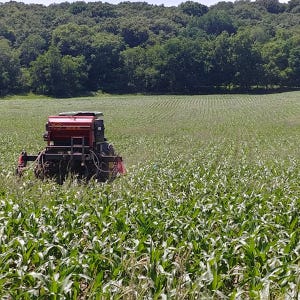June 24, 2020

The Iowa Nutrient Reduction Strategy has recognized cover crops as a viable approach to reducing nitrogen and phosphorus losses to surface and groundwaters. Because of increased cost-share funding, more opportunities for educational programs and a growing body of research, cover crop adoption continues to grow in Iowa. Today, there are increased opportunities for cost-share dollars to implement cover crops; however, the rate of adoption is slower now than three years ago, according to the Iowa Learning Farms.
One of the barriers often cited as holding back cover crop adoption is the ability to establish cover crop species following a corn cash crop. Aerial seeding methods have their limitations, as well as timing of drilling operations after the harvest season. With these two methods currently being used by Iowa farmers, there is an increased demand for new research on interseeding cover crops into an early vegetative stage of a corn cash crop. Interseeded cover crops are touted to suppress weed emergence, fix nitrogen in the soil, control erosion, reduce nutrient loss, build soil health and provide forage for livestock.
Interseeding’s prospects in Iowa
In general, there has been more interseeding research done in the northern Corn Belt and Mid-Atlantic states than in the central Corn Belt. These two regions have found cool-season species that are drought- and shade-tolerant, ideally suited for interseeding into vegetative-stage corn. However, the ability of interseeded cover crops to overwinter following corn harvest hasn’t been consistently shown.
 TALL CORN: In this Monona County, Iowa, trial, the cover crop is being interseeded between corn rows at the V7 growth stage.
TALL CORN: In this Monona County, Iowa, trial, the cover crop is being interseeded between corn rows at the V7 growth stage.

Another concern is that interseeded cover crop performance at the V5 to V8 stage of corn growth is enhanced at lower corn plant densities and earlier relative maturities. While these practices can work in other areas, they aren’t well-adapted to maximize corn yield in Iowa. Cover crop interseeding needs further research to understand how the interseeding interacts with modern corn hybrids under Iowa climate and soil conditions.
Recommendations on cover crop species and seeding timing from other regions, although helpful, have not always shown repeatability in Iowa or the central Corn Belt.
Iowa State University, through a grant from the Iowa Nutrient Research Center, is exploring different questions about this practice over the next few years. The ISU research will focus on development of best management practices for cover crop species selections, as well as interseeding timing within a vegetative corn cash crop in Iowa.
Interseeding trials expanding
In 2019, ISU researchers placed small demonstration plots around the state to determine if certain species had the ability to survive within a cornfield environment. While the results were mixed and not conclusive, there was enough evidence to focus the new research on the use of winter rye, annual ryegrass, red clover and cowpeas. Not every available cover crop species was tested, and others may prove more viable in the future; however, these species displayed potential for interseeding use.
These individual species and some mixes will be grown at ISU Research Farms as well as in on-farm demonstration trials across the western half of Iowa in 2020. They’ll be grown in additional areas of the state next year and in years beyond. The cover crops are planted with a four-row interseeding machine using a Gandy seeder and Dawn DuoSeed row units, which will plant two rows of cover crops between each row of corn. These seeds are not broadcast on the soil surface, but instead are planted at a depth consistent with species recommendations to improve germination and growth.
Experiments and demonstrations will test the different species at recommended planting rates as well as multiple interseeding timings. Interseeding will occur at the V5 and V8 corn growth stages to determine if there is a greater cover crop biomass and survivability for each species. Corn grain yield will also be collected at the end of the season to determine if the interseeded cover crops had a detrimental effect on the corn cash crop.
While the goals of this project are to provide initial best management practices for interseeding cover crops in Iowa, it will likely illuminate other risks with this practice.
More questions than answers
Potential issues of herbicide programs, weed control, soil conditions and timing will no doubt be challenging for farmers with this practice. However, interseeding may be an opportunity to get a cover crop established when farmers can easily get into the field, instead of waiting for fall when there is limited time for establishment and growth. ISU researchers are committed to further exploration of these factors that will fill a critical knowledge gap to guide best management practices for interseeding cover crops into a corn cash crop in Iowa.
Witt is the ISU Extension field agronomist covering west central Iowa. Email him at [email protected].
About the Author(s)
You May Also Like






